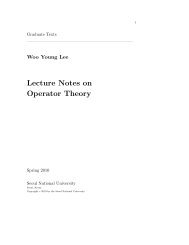Categorification of Donaldson-Thomas invariants via perverse ...
Categorification of Donaldson-Thomas invariants via perverse ...
Categorification of Donaldson-Thomas invariants via perverse ...
You also want an ePaper? Increase the reach of your titles
YUMPU automatically turns print PDFs into web optimized ePapers that Google loves.
6 YOUNG-HOON KIEM AND JUN LIL−K in the link bundle π : L → S. The equivalence <strong>of</strong> categories is explicitly givenby sending P • ∈ P erv(X) to B • = P • | X−S together with the natural morphismsR −c−1 π ∗ κ ∗ κ ∗ B • R −c π ∗ γ ! γ ∗ B •mR −c π ∗ ϕ ! ϕ ∗ P • nwhere ϕ : D − K ↩→ D is the inclusion into the normal slice bundle.See [22, §4] for precise definitions <strong>of</strong> K, L and D. Morally the above theoremsays that an extension <strong>of</strong> a <strong>perverse</strong> sheaf on X − S to X is obtained by adding asheaf on S. Since sheaves glue, we can glue <strong>perverse</strong> sheaves stratum by stratum.Pro<strong>of</strong> <strong>of</strong> Proposition 2.6. We stratify X by complex manifolds and let X (i) denotethe union <strong>of</strong> strata <strong>of</strong> codimension ≤ i. On the smooth part X (0) , P • α are honestsheaves and hence they glue to a sheaf P • | X (0). For X (1) = X (0) ∪ S, we find thatsince P • α are isomorphic on intersections X α ∩ X β , the sheaves R −c π ∗ ϕ ! ϕ ∗ P • α glueand so do the natural triangles(2.2) R −2 π ∗ κ ∗ κ ∗ (P • | X (0)) R −1 π ∗ γ ! γ ∗ (P • | X (0))mR −1 π ∗ ϕ ! ϕ ∗ P • α.nHence we obtain a <strong>perverse</strong> sheaf P • | X (1) ∈ P erv(X (1) ). It is obvious that we cancontinue this way using Theorem 2.7 above until we obtain a <strong>perverse</strong> sheaf P • onX such that P • | Xα = P α.•The gluing <strong>of</strong> isomorphisms is similar.□Another application <strong>of</strong> Theorem 2.7 is the following rigidity property <strong>of</strong> <strong>perverse</strong>sheaves.Lemma 2.8. Let P • be a <strong>perverse</strong> sheaf on an analytic variety U. Let π : T → Ube a continuous map from a topological space T with connected fibers and let T ′ bea subspace <strong>of</strong> T such that π| T ′ is surjective. Suppose an isomorphism µ : π −1 P • ∼ =π −1 P • satisfies µ| T ′ = id (π −1 P • )| T ′. Then µ = id π −1 P •.Pro<strong>of</strong>. We first prove the simple case: if we let C be a locally constant sheaf overQ <strong>of</strong> finite rank on Z ⊂ U and ¯µ : π −1 C → π −1 C be a homomorphism such that¯µ| T ′ ∩π −1 (Z) = id, then ¯µ is the identity morphism. Indeed, since the issue is local,we may assume that Z is connected and that C ∼ = Q r so that ¯µ : Q r → Q r is givenby a continuous map π −1 (Z) → GL(r, Q). By connectedness, this obviously is aconstant map which is 1 along T ′ ∩π −1 (Z). We thus proved the lemma in the sheafcase.For the general case, we use Theorem 2.7. As in the pro<strong>of</strong> <strong>of</strong> Proposition 2.6above, we stratify U and let U (i) be the union <strong>of</strong> strata <strong>of</strong> codimension ≤ i. Since P •is a <strong>perverse</strong> sheaf, P • | U (0)[− dim U] is isomorphic to a locally constant sheaf andhence µ| U (0) is the identity map. For U (1) = U (0) ∪S, using the notation <strong>of</strong> Theorem2.7, C = R −1 π ∗ ϕ ! ϕ ∗ P • is a locally constant sheaf and µ induces a homomorphismπ −1 C → π −1 C which is identity on T ′ ∩ π −1 (S). Therefore µ induces the identity













